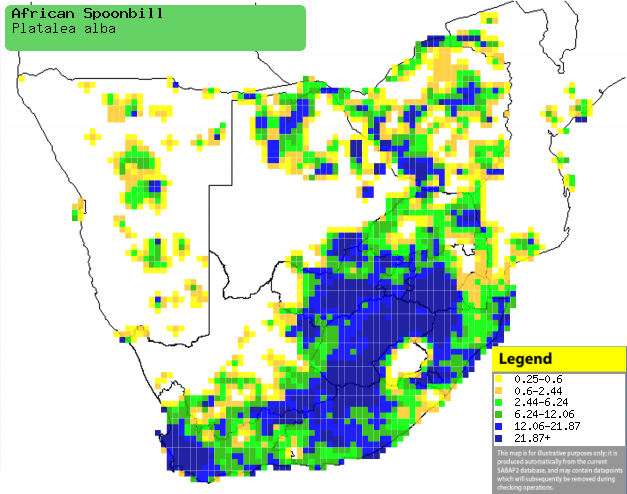Platalea alba (African
spoonbill)
Lepelaar [Afrikaans]; iNkenkane,
isiXulamasele [Zulu]; Molomo-khaba [South Sotho]; Afrikaanse lepelaar [Dutch];
Spatule d'Afrique [French]; Afrikanischer löffler [German]; Colhereiro-africano
[Portuguese]
Life
> Eukaryotes >
Opisthokonta
> Metazoa (animals) >
Bilateria >
Deuterostomia > Chordata >
Craniata > Vertebrata (vertebrates) > Gnathostomata (jawed
vertebrates) > Teleostomi (teleost fish) > Osteichthyes (bony fish) > Class:
Sarcopterygii (lobe-finned
fish) > Stegocephalia (terrestrial
vertebrates) > Tetrapoda
(four-legged vertebrates) > Reptiliomorpha > Amniota >
Reptilia (reptiles) >
Romeriida > Diapsida > Archosauromorpha > Archosauria >
Dinosauria
(dinosaurs) > Saurischia > Theropoda (bipedal predatory dinosaurs) >
Coelurosauria > Maniraptora > Aves
(birds) > Order: Ciconiiformes
> Family: Threskiornithidae
Distribution and habitat
Occurs in a narrow horizontal band from Senegal to
Ethiopia, extending south through Uganda, Kenya, eastern DRC, Tanzania, Zambia
and Angola to South Afric. It can occupy almost any shallow water body,
generally preferring the margins of rivers or lakes, pans, marshes, flood
plains, sewage works, dams, coastal estuaries and lagoons; it mainly breeds in
swamps with stands of sedges (Juncus) and reeds (Phragmites).
|
 |
|
Distribution of African spoonbill in southern Africa,
based on statistical smoothing of the records from first SA Bird Atlas
Project (©
Animal Demography unit, University of
Cape Town; smoothing by Birgit Erni and Francesca Little). Colours range
from dark blue (most common) through to yellow (least common).
See here for the latest distribution
from the SABAP2. |
Predators and parasites
Its chicks and eggs have been recorded as prey of
Corvus splendens (House
crow).
Movements and migrations
Nomadic, as it moves in response to rainfall
and habitat availability.
Food
It mainly eats small fish and aquatic invertebrates,
foraging by wading through the water while sweeping its bill from side to side,
snapping prey up instinctively when its bill makes contact. Its oddly-shaped bill is adapted for this technique, as the spoon
shape makes it easier it to grab slippery prey. It also follows Nile crocodiles
(Crocodylus niloticus) and Hippopotamuses (Hippopotamus amphibius),
catching animals they disturb.
Breeding
- Mainly monogamous, although males often attempt to copulate other females,
nesting in colonies of 5-20, occasionally up to 150-200 pairs. Other water
birds frequently join the colonies, such as
African darters and
herons.
- The nest is built solely by the female with material brought by the
male, consisting of a flat oval structure of sticks, creepers, reeds and
twigs, sometimes lined with grass. It is typically placed on a partially
submerged tree, bush, reedbed or rocky islet.
- Egg-laying season is mainly from July-November in southern Africa,
although in Botswana and Namibia it is from February-August.
- It lays 2-4 eggs, which are incubated by both sexes for about 25-29
days.
- The chicks are fed by both parents by regurgitation, wandering around
the vicinity the nest from 21 days old and leaving the colony completely at
about five weeks old.
Threats
Not threatened.
References
-
Hockey PAR, Dean WRJ and Ryan PG 2005. Roberts
- Birds of southern Africa, VIIth ed. The Trustees of the John Voelcker
Bird Book Fund, Cape Town.
|
